- from 750,000 to 400,000 years ago (Acheulean and ancient Clactonian);
- from 400,000 to 200,000 years ago (Acheulean and Middle Clactonian);
- from 200,000 to 40,000 years ago (Acheulean and Final Clactonian, and Mousterian);
- from 40,000 to 12,000 years ago (Upper Paleolithic).
The typology of the sculptures is constituted by the representation of animal heads, mostly mammals without neck (Fig. 7,1). Between 400,000 and 200,000 years ago the head is represented with the body in horizontal position and without limbs (Fig. 7,3).
In the stone sculpture of the Paleolithic, mammals are represented without horns, without tusks and without ears.
It is probable that the religion of the painters of animals in caves (Solutrean and Magdalenian) of the Upper Paleolithic derived from the religion of the producers of animal heads.
This type of sculpture in the Mousterian and Upper Paleolithic represents also the heads of felines. In Dolni Vestonice in Moravia, Czechoslovakia during the Upper Paleolithic (Gravettian) the heads of felines were modeled in clay and have the ears – something that would have been impossible or difficult to realize in flint or in hard stone.


Fig. 7.1) Zoomorphic stone sculpture.
It represents a mammal head, possibly a horse. The eyes are not represented, but a generic orbital zone is perceptible. The sculpture is obtained from a flint nodule, of which part of the original shape was used; this can be deduced from the remaining crust represented with dots in the drawing. The stylistic deformation can be interpreted by the curving of the muzzle too, which has its own elegance. The working technique consists of knocking off pieces.
Length: 8.6 inches.
Origin: Rodi Garganico, Foggia, Italy.
Material culture: Clactonian or early Acheulean.
Collection of the Museum of the Origins of Man.

It represents a mammal head, possibly an elephant or mammoth, as it has the pointed neck and the snout inclined, turned right at the tip like a proboscis. It is obtained from a nodule of flint. It is worked from every part, and the only trace of crust (as we can see in the photo) is between the muzzle and the nape. The part underneath (base) is hollowed out, as in other anthropomorphic sculptures, to emphasize the jaw.
Height: 3.5 inches.
Origin: Rodi Garganico, Foggia, Italy.
Material culture: Clactonian or early Acheulean.
Collection of the Museum of the Origins of Man.



It represents a mammal head with body and without limbs. It is one of the few sculptures of this type found, and the most ancient. The working technique is exceptional in how much the body is realized with great longitudinal chipping on six sides (see section in the drawing), while the head has a section of five sides, with accurate elaboration of the snout. This sculpture in flint is completely worked across the entire surface, and no trace of crust is visible.
Length: 2.5 inches.
Origin: Rodi Garganico, Foggia, Italy.
Material culture: Clactonian or Middle Acheulean.
Collection of the Museum of the Origins of Man.



It represents a mammal head with body and without limbs. It is one of the few sculptures of this type found, and the most ancient. The working technique is exceptional in how much the body is realized with great longitudinal chipping on six sides (see section in the drawing), while the head has a section of five sides, with accurate elaboration of the snout. This sculpture in flint is completely worked across the entire surface, and no trace of crust is visible.
Length: 2.5 inches.
Origin: Rodi Garganico, Foggia, Italy.
Material culture: Clactonian or Middle Acheulean.
Collection of the Museum of the Origins of Man.
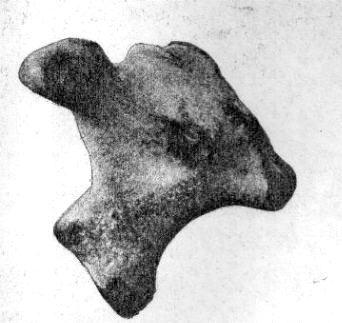
It represents a mammal head, probably a fawn. This photograph was published by A. THIEULLEN in 1900. In this old photo the traces of working on the stone are not visible, therefore it is not possible to establish if the sculpture has been obtained from a nodule of flint naturally zoomorphic, but intentionally retouched, or if it is a totally natural nodule that would indicate a FALSE. All of the early archaeologists made errors of interpretation, with the stone tools as well, and with remains of human fossils.
A propensity for FALSE is confirmed in the typology of the sculptures of mammal heads of the Lower Paleolithic, where neither the ears, nor the neck are represented; however, it is not to exclude that the hominid, if he found zoomorphic nodules, could use them, improving their shape with a few retouches, but in so doing, always leaving the imprint of a typology that we know today.
Height: approx. 2 inches.
Material culture: generically Clactonian or Middle Acheulean.
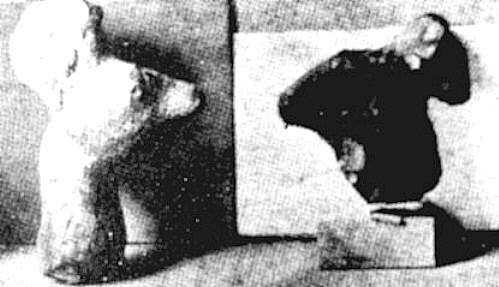
These sculptures ("figure stones") are very suggestive, and our suspicion they are FALSE is based on these deductions: - in the hundred successive years following these discoveries (that is until today), no Lower Paleolithic sculptures of mammal heads with horns were ever found; moreover, all the mammals are represented with a single head and without the neck, except those that have a body without limbs.
- the dimensions that Harroy gives of his sculptures of cervids, which were numerous, vary from 1.1 to 1.9 inches in height. Sculptures in flint of such dimensions are too small to be worked. Probably he has found some quarries with small nodules of flint, among which he has performed extensive selections, collecting what seemed to him plausible.
It is however important to see the findings and studies of the first researchers of sculptures of the Lower and Middle Paleolithic to see how there is much to discover, obviously discarding the ERRORS that have been made.


It represents a feline head, probably a lion, with holes (corresponding to the eyes and nostrils) predisposed for hanging it with ropes.
This head has the mouth wide open to represent a roar. It is realistically and well-proportioned, although the stylistic language deforms it a little, even if in an elegant sense.
The material used is red travertine, so it isn't possible to verify the totality of the worked surface as can be done with flint nodules. The jaw is quite well worked and depicted; the ears are also represented but one is partially broken and missing.
Dimensions: height 11.8 inches, length 14.5 inches.
Origin: Arma delle Manie, Finale Ligure, Savona, Italy.
Material culture: Mousterian.
Collection of the Museum of the Origins of Man.
The Arma delle Manie, now Archaeological Site of National Interest, is a large cave that has been excavated in its Middle and Upper Paleolithic layers, where remains of Ursus speleus were found. (Excavations of G. Isetti 1963, 1964, 1965; of O. Giuggiola 1967; it was occasionally explored by other archaeologists until recently). The cave has always been a source for prehistoric scholars. This sculpture was been found in 1975 by P. Gaietto inside the Arma delle Manie among the "excavation scraps" it was far from hidden, but none of the archaeologists in charge of the excavations, and not even other visiting archaeologists, had noticed it. This can be explained by the disinterest of the majority of archaeologists for art of the Lower and Middle Paleolithic, of which they are not even aware of the existence, and consequently they do not know how to recognize it.

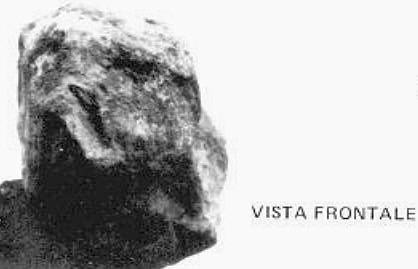
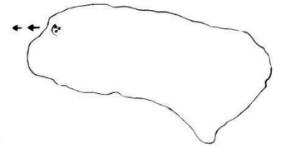
San Pietro d'Olba is a mid-mountain town a few kilometers from the Mediterranean, and at that time seals were certainly numerous. The representation of the head is "all around"; it has two eyes; in the area of the nose there is a break and a piece is missing (see photograph: frontal view).
Length: 16.9 inches.
Origin: San Pietro d'Olba, Savona, Italy.
Material culture: Upper Paleolithic.
Collection of the Museum of the Origins of Man.

Height: 1.5 inches.
Origin: the Basura cave, Toirano, Savona, Liguria, Italy.
Material culture: Mousterian or Upper Paleolithic.
Collection of the Museum of the Origins of Man.
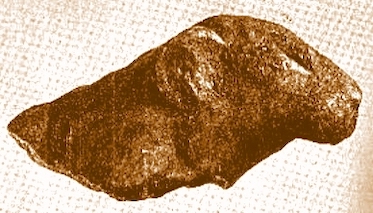
Length: 2.3 inches.
Origin: Dolni Vestonice, Moravia, Czechoslovakia.
Material culture: Upper Paleolithic (Gravettian).
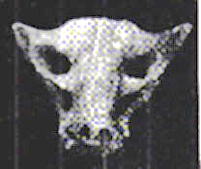
The discoverers defined it as a "skull" we think it is an artistic hybrid of life and death, as the general representation is of a skull, but the ears are of a living wolf.
Dimensions: very small, as it has been carved from the pelvis bone of a llama.
Origin: Tepexpan, Mexico. It comes from an archaeological layer with mammoth remains, and was dated to 10,000 years ago.
Material culture: a civilization of the final Paleolithic.
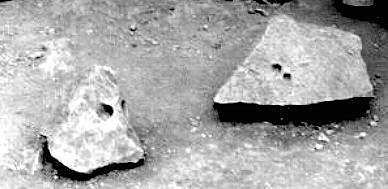
In Dordogne, where we photographed these, a guide argued that they are zoomorphic sculptures of the Aurignacian I. It is difficult to make a judgment or define the stylistic language. They are defined as sculptures "à anneau"(ring sculptures) and we were told that through those holes a rope was passed and they were suspended. It is only a hypothesis, but it is plausible.
Location : Sergeac, at the Fort Troglodytique des Anglais, Dordogne, France. Material culture: Upper Paleolithic (Aurignacian I).
(Photo by Licia Filingeri, 1977.)
Location: : Sergeac, at the Fort Troglodytique des Anglais, Dordogne, France.
Material culture: Upper Paleolithic (Aurignacian I).
(Photo by Licia Filingeri, 1977.)
Page translated from Italian into English by Paris Alexander Walker.
Copyright©2020 by Museum of Origins of Man, all rights reserved.